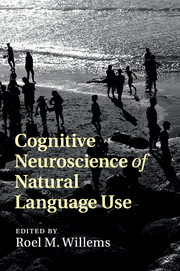Book contents
- Cognitive Neuroscience of Natural Language Use
- Cognitive Neuroscience of Natural Language Use
- Copyright page
- Contents
- Plates
- Figures
- Contributors
- Abbreviations
- 1 Cognitive neuroscience of natural language use: introduction
- 2 fMRI methods for studying the neurobiology of language under naturalistic conditions
- 3 Why study connected speech production?
- 4 Situation models in naturalistic comprehension
- 5 Language comprehension in rich non-linguistic contexts: combining eye-tracking and event-related brain potentials
- 6 The NOLB model: a model of the natural organization of language and the brain
- 7 Towards a neurocognitive poetics model of literary reading
- 8 Putting Broca’s region into context: fMRI evidence for a role in predictive language processing
- 9 Towards a multi-brain perspective on communication in dialogue
- 10 On the generation of shared symbols
- 11 What are naturalistic comprehension paradigms teaching us about language?
- Index
8 - Putting Broca’s region into context: fMRI evidence for a role in predictive language processing
Published online by Cambridge University Press: 05 February 2015
- Cognitive Neuroscience of Natural Language Use
- Cognitive Neuroscience of Natural Language Use
- Copyright page
- Contents
- Plates
- Figures
- Contributors
- Abbreviations
- 1 Cognitive neuroscience of natural language use: introduction
- 2 fMRI methods for studying the neurobiology of language under naturalistic conditions
- 3 Why study connected speech production?
- 4 Situation models in naturalistic comprehension
- 5 Language comprehension in rich non-linguistic contexts: combining eye-tracking and event-related brain potentials
- 6 The NOLB model: a model of the natural organization of language and the brain
- 7 Towards a neurocognitive poetics model of literary reading
- 8 Putting Broca’s region into context: fMRI evidence for a role in predictive language processing
- 9 Towards a multi-brain perspective on communication in dialogue
- 10 On the generation of shared symbols
- 11 What are naturalistic comprehension paradigms teaching us about language?
- Index
Summary
Broca’s region is known to play a key role in speech production as well as in the processing of language input. Still, the exact function (or functions) of Broca’s region remains highly disputed. Within the generativist framework it has been argued that part of Broca’s region is dedicated to syntactical analysis. Others, however, have related Broca’s region activity to more domain-general processes, e.g. working memory load and argument hierarchy demands. We here present results that show how contextual cues completely alter the effects of syntax in behaviour and in Broca’s region, and suggest that activation in this area reflects general linguistic processing costs or prediction error. We review the fMRI literature in the light of this theory.
- Type
- Chapter
- Information
- Cognitive Neuroscience of Natural Language Use , pp. 160 - 181Publisher: Cambridge University PressPrint publication year: 2015
- 4
- Cited by

